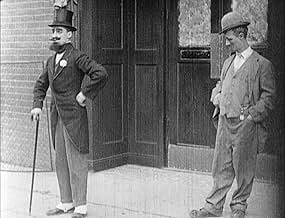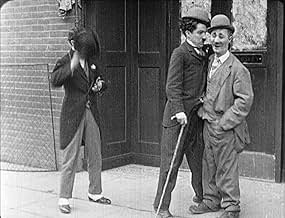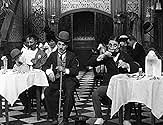After a visit to a pub, Charlie and Ben cause a ruckus at a posh restaurant. Charlie later finds himself in a compromising position at a hotel with the head waiter's wife.After a visit to a pub, Charlie and Ben cause a ruckus at a posh restaurant. Charlie later finds himself in a compromising position at a hotel with the head waiter's wife.After a visit to a pub, Charlie and Ben cause a ruckus at a posh restaurant. Charlie later finds himself in a compromising position at a hotel with the head waiter's wife.
Ben Turpin
- Fellow Reveller
- (uncredited)
Charles Allen Dealey
- Restaurant Manager
- (uncredited)
Frank Dolan
- Waiter
- (uncredited)
W. Coleman Elam
- Bit Role
- (uncredited)
Earl Esola
- Bellboy with Cigar Boxes
- (uncredited)
Eddie Fries
- Bit Role
- (uncredited)
Fred Goodwins
- Desk Clerk at Second Hotel
- (uncredited)
Madrona Hicks
- Veiled Woman
- (uncredited)
Bud Jamison
- Headwaiter
- (uncredited)
Daniel P. Kelleher
- Bellboy Carrying Suitcases
- (uncredited)
Edna Purviance
- Headwaiter's Wife
- (uncredited)
Eva Sawyer
- The Count's Companion
- (uncredited)
Lee Willard
- Soup Slurper
- (uncredited)
Fred Windemere
- Cop
- (uncredited)
- Director
- Writer
- All cast & crew
- Production, box office & more at IMDbPro
Featured reviews
Upon finishing "His New Job," Chaplin had enough of the cold midwestern weather and decided to return to California where Essanay had a small studio 30 miles outside of San Francisco. Part studio owner and cowboy actor Max Anderson had earlier established a facility to shoot and edit his Westerns for the mountainous typography.
For his next film, February 1915's "A Night Out," Chaplin was yearning to find a leading comic actress similar to Keystone's Mabel Normand, but without all the drama associated with filming with her. There are varying stories how Chaplin discovered a 19-year-old secretary, Edna Purviance, to be selected for that acting position. Either through an audition, spotting her in a San Francisco lobby, or through an introduction, Chaplin was intriqued with her looks and picked Purviance despite his reservations she never had acted in front of a camera before.
Despite her humble opinion she had stunk up the joint in her first film, Purviance performed well enough in "A Night Out" to continue a stretch of 33 films where she was that funny lady opposite of Chaplin. To boot, she also had a romantic relationship with him for the next three years.
"His Night Out" is also noteworthy as being the first movie where Chaplin met cameraman Rollie Totheroh, who was working with Anderson and his Westerns.. Totheroh would soon become Chaplin's director of photography throughout his career, all the way until the mid-1950's.
For his next film, February 1915's "A Night Out," Chaplin was yearning to find a leading comic actress similar to Keystone's Mabel Normand, but without all the drama associated with filming with her. There are varying stories how Chaplin discovered a 19-year-old secretary, Edna Purviance, to be selected for that acting position. Either through an audition, spotting her in a San Francisco lobby, or through an introduction, Chaplin was intriqued with her looks and picked Purviance despite his reservations she never had acted in front of a camera before.
Despite her humble opinion she had stunk up the joint in her first film, Purviance performed well enough in "A Night Out" to continue a stretch of 33 films where she was that funny lady opposite of Chaplin. To boot, she also had a romantic relationship with him for the next three years.
"His Night Out" is also noteworthy as being the first movie where Chaplin met cameraman Rollie Totheroh, who was working with Anderson and his Westerns.. Totheroh would soon become Chaplin's director of photography throughout his career, all the way until the mid-1950's.
Though there are some good moments, mostly later in the feature, overall this short comedy has too much of the same basic material, and it starts to get old rather soon. Charlie Chaplin and Ben Turpin play a couple of drunks who cause a series of difficulties for each other and for those with whom they come in contact. They both do a creditable job (in itself) of performing the material, but it is just too much of the same thing. Drunkenness just is not funny enough to carry even a short feature all by itself, and the use of it as a pretext for the characters to behave in a chronically impolite fashion wears thin relatively quickly.
Things do get a little better in the second half, when the material and the plot become somewhat less one-dimensional. Then too, anything with Chaplin in it will have some good moments - but overall, "A Night Out" is below Chaplin's usual standard. It's probably most memorable for the first of Edna Purviance's many appearances in a Chaplin movie.
Things do get a little better in the second half, when the material and the plot become somewhat less one-dimensional. Then too, anything with Chaplin in it will have some good moments - but overall, "A Night Out" is below Chaplin's usual standard. It's probably most memorable for the first of Edna Purviance's many appearances in a Chaplin movie.
One of Chaplin's better efforts from his early days at Essanay which isn't really that much of a recommendation, as both Chaplin and his creation were far from the finished article when this was made. With his exaggerated motions and heavy-eyed contemplation of things he can't quite understand due to his inebriated state, Chaplin exquisitely captures the behaviour of one who has had more than one too many. He's partnered for the first time with Edna Purviance here, and they work well together. The story itself is typical of the violence with which Chaplin's work seemed to be obsessed at this time. He had obviously found a formula that worked
This was Charlie Chaplin's second picture at Essanay studios, and his second to co-star Essanay's resident funny man Ben Turpin, who had been with the studio since its first picture in 1907. With the exception of his earliest Keystone appearances, many of which were ensemble pieces, A Night Out is perhaps the closest Charlie came to being part of a double act.
Turpin was neither as versatile or inventive as Chaplin, but he had bags of experience and his movements were spot on. In particular, and importantly for this picture, he could do a great drunken lurch and could pratfall superbly. Here he has almost as much screen time as the tramp himself, and even gets a few bits of comedy business to himself. Chaplin's male co-stars tended to be the butt of much of the physical comedy, and because he falls so well, every time he gets knocked down he draws attention to himself and away from Charlie. Turpin is hilarious here and he really lends something to this picture, but to progress Chaplin couldn't let anyone share his limelight, and it's no surprise that the pair would make just one more picture together.
Like most of the early Essanay shorts, A Night Out doesn't really have much in the way of plot, being simply the tramp (or, in this case, tramps) wandering around causing mayhem in an established environment. Although the result is not entirely satisfying, Chaplin does take time to develop his tramp character with drawn out comedy routines and interaction with the props and people of the setting. He is continually reducing the number of edits and keeping each series of gags to a single shot. For example, in the Keystone pictures and his first Essanay picture (His New Job), when characters get pushed over, more often than not there is a cut showing them flying into the next frame. However, in those early scenes in the restaurant in A Night Out, whenever people fall down it's towards the back of the room, so as not to break the flow at this more relaxed stage of the picture. Chaplin does however put in a few of these two-shot pratfalls towards the end to liven up the frantic finale.
A Night Out marks the debut of Edna Purviance, who would be Chaplin's only leading lady for the next eight years. Chaplin didn't demand his female leads become part of the comedy, he only required them to act well, and Purviance was a superlative actress. She is a relatively minor figure in this one however, although Chaplin does treat her to one of his rare close-ups. A Night Out is also the first time we get to see Leo White's "French character". White was another hilarious supporting player in the Chaplin troupe, who at times would also threaten to upstage Charlie, although his comic persona – a stuck-up, straight-laced twerp – was so different to Chaplin's that he made a perfect counterfoil and antagonist for the tramp. Ben Turpin however was too similar to Chaplin's tramp character, so his days as Charlie's sidekick were numbered. A Night Out is the best opportunity to see him in action.
And now, the all-important statistic –
Number of kicks up the arse: 4 (3 for, 1 against)
Turpin was neither as versatile or inventive as Chaplin, but he had bags of experience and his movements were spot on. In particular, and importantly for this picture, he could do a great drunken lurch and could pratfall superbly. Here he has almost as much screen time as the tramp himself, and even gets a few bits of comedy business to himself. Chaplin's male co-stars tended to be the butt of much of the physical comedy, and because he falls so well, every time he gets knocked down he draws attention to himself and away from Charlie. Turpin is hilarious here and he really lends something to this picture, but to progress Chaplin couldn't let anyone share his limelight, and it's no surprise that the pair would make just one more picture together.
Like most of the early Essanay shorts, A Night Out doesn't really have much in the way of plot, being simply the tramp (or, in this case, tramps) wandering around causing mayhem in an established environment. Although the result is not entirely satisfying, Chaplin does take time to develop his tramp character with drawn out comedy routines and interaction with the props and people of the setting. He is continually reducing the number of edits and keeping each series of gags to a single shot. For example, in the Keystone pictures and his first Essanay picture (His New Job), when characters get pushed over, more often than not there is a cut showing them flying into the next frame. However, in those early scenes in the restaurant in A Night Out, whenever people fall down it's towards the back of the room, so as not to break the flow at this more relaxed stage of the picture. Chaplin does however put in a few of these two-shot pratfalls towards the end to liven up the frantic finale.
A Night Out marks the debut of Edna Purviance, who would be Chaplin's only leading lady for the next eight years. Chaplin didn't demand his female leads become part of the comedy, he only required them to act well, and Purviance was a superlative actress. She is a relatively minor figure in this one however, although Chaplin does treat her to one of his rare close-ups. A Night Out is also the first time we get to see Leo White's "French character". White was another hilarious supporting player in the Chaplin troupe, who at times would also threaten to upstage Charlie, although his comic persona – a stuck-up, straight-laced twerp – was so different to Chaplin's that he made a perfect counterfoil and antagonist for the tramp. Ben Turpin however was too similar to Chaplin's tramp character, so his days as Charlie's sidekick were numbered. A Night Out is the best opportunity to see him in action.
And now, the all-important statistic –
Number of kicks up the arse: 4 (3 for, 1 against)
Am a big fan of Charlie Chaplin, have been for over a decade now. Many films and shorts of his are very good to masterpiece, and like many others consider him a comedy genius and one of film's most important and influential directors.
From his Essanay period after leaving Keystone, 'A Night Out' is not one of his very best or even among the best of this particular period. It shows a noticeable step up in quality though from his Keystone period, where he was still evolving and in the infancy of his long career, from 1914, The Essanay period is something of Chaplin's adolescence period where his style had been found and starting to settle. Something that can be seen in the more than worthwhile 'A Night Out'.
'A Night Out' is not one of his all-time funniest or most memorable, other efforts also have more pathos and a balance of that and the comedy. The story is still a little flimsy, there are times where it struggles to sustain the short length, and could have had more variety and less more of the same repeition.
On the other hand, 'A Night Out' looks pretty good, not incredible but it was obvious that Chaplin was taking more time with his work and not churning out countless shorts in the same year of very variable success like he did with Keystone. Appreciate the importance of his Keystone period and there is some good stuff he did there, but the more mature and careful quality seen here and later on is obvious.
While not one of his funniest or original, 'A Night Out' is still very entertaining with some clever, entertaining and well-timed slapstick. It moves quickly and there is no dullness in sight.
Chaplin directs more than competently, if not quite cinematic genius standard yet. He also, as usual, gives an amusing and expressive performance and at clear ease with the physicality of the role. The supporting cast acquit themselves well, with an amusing Ben Turpin and charming Edna Purviance in her first collaboration with Chaplin.
In summation, worth watching if not to watch over and over. 7/10 Bethany Cox
From his Essanay period after leaving Keystone, 'A Night Out' is not one of his very best or even among the best of this particular period. It shows a noticeable step up in quality though from his Keystone period, where he was still evolving and in the infancy of his long career, from 1914, The Essanay period is something of Chaplin's adolescence period where his style had been found and starting to settle. Something that can be seen in the more than worthwhile 'A Night Out'.
'A Night Out' is not one of his all-time funniest or most memorable, other efforts also have more pathos and a balance of that and the comedy. The story is still a little flimsy, there are times where it struggles to sustain the short length, and could have had more variety and less more of the same repeition.
On the other hand, 'A Night Out' looks pretty good, not incredible but it was obvious that Chaplin was taking more time with his work and not churning out countless shorts in the same year of very variable success like he did with Keystone. Appreciate the importance of his Keystone period and there is some good stuff he did there, but the more mature and careful quality seen here and later on is obvious.
While not one of his funniest or original, 'A Night Out' is still very entertaining with some clever, entertaining and well-timed slapstick. It moves quickly and there is no dullness in sight.
Chaplin directs more than competently, if not quite cinematic genius standard yet. He also, as usual, gives an amusing and expressive performance and at clear ease with the physicality of the role. The supporting cast acquit themselves well, with an amusing Ben Turpin and charming Edna Purviance in her first collaboration with Chaplin.
In summation, worth watching if not to watch over and over. 7/10 Bethany Cox
Did you know
- TriviaThis was Edna Purviance's first film with Charles Chaplin.
- GoofsThe hotel number for Reveller (Charlie Chaplin) and Fellow Reveller changes. When Fellow Reveller first enters the room the number on the door is clearly visible as 3. When Reveller is followed into the room by Headwaiter the room number changes to 2. It changes back to 3 when Fellow Reveller leaves the room for the final time.
- ConnectionsEdited into The Essanay-Chaplin Revue of 1916 (1916)
Details
- Release date
- Country of origin
- Official sites
- Languages
- Also known as
- Charlot en bombe
- Filming locations
- Production company
- See more company credits at IMDbPro
- Runtime
- 34m
- Color
- Sound mix
- Aspect ratio
- 1.33 : 1
Contribute to this page
Suggest an edit or add missing content



























